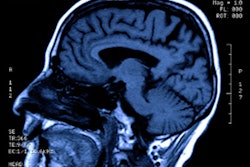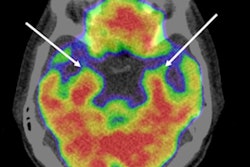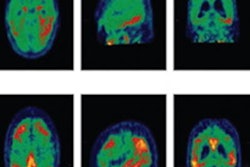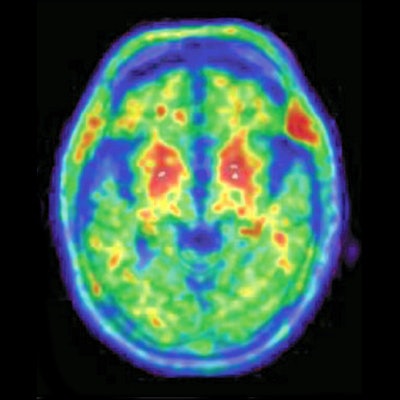
PET imaging with flortaucipir revealed uptake patterns indicative of chronic traumatic encephalopathy (CTE) in a new study published online January 6 in JAMA Neurology, but the tau-binding radiotracer is not quite ready to be declared a reliable biomarker for the condition, the authors noted.
To be clear, the findings involved only one individual -- a former professional football player turned professional stuntman, who eventually developed mild Parkinson's disease before his death at age 72. While he was alive, researchers from the University of California, San Francisco (UCSF) performed flortaucipir-PET scans and later compared those results with the subject's postmortem brain tissue.
"We detected elevated flortaucipir binding during life in a pattern that generally corresponded to CTE pathology postmortem," wrote the authors, led by Dr. William Mantyh, a behavioral neurology clinical fellow in UCSF's Memory and Aging Center. "However, the relatively low signal intensity and only modest correlation between PET and autopsy findings suggest that flortaucipir may have limited utility as a biomarker of tau pathology in CTE."
PET with flortaucipir (Avid Radiopharmaceuticals) has shown promise in a number of recent studies with its ability to bind tau neurofibrillary tangles in postmortem brain tissue of Alzheimer's patients. A 2020 study by these same UCSF researchers found that tau buildup predicted with more than 40% accuracy subsequent brain atrophy in the same locations as the eventual development of Alzheimer's. In a September 2019 study, U.K. and Swedish researchers used flortaucipir-PET to uncover tau accumulation in brain regions associated with CTE.
"No study, however, has assessed the correlation between in vivo flortaucipir-PET and postmortem tau in CTE," Mantyh and colleagues noted.
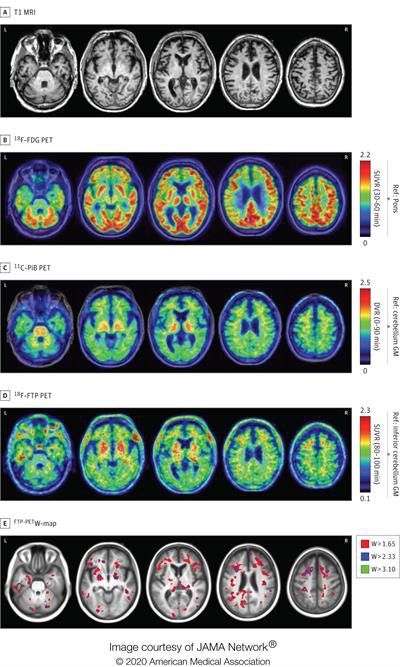

T1-weighted MR images (top row) demonstrate mild medial temporal and frontal atrophy. FDG-PET images (second row) show mild hypometabolism in the medial temporal, medial and dorsolateral frontal, and peri-insular regions, while the PiB-PET images (third row) were visually rated as negative for cortical retention. Flortaucipir-PET (fourth row) shows widespread patchy binding predominantly in the left greater than right frontotemporal areas. The flortaucipir-PET maps (bottom row) show that these focal increases are higher than what would be expected considering the patient's age. DVR: distribution volume ratio, GM: gray matter, Ref: reference region, and SUVR: standardized uptake value ratio with acquisition windows in parentheses. Images courtesy of JAMA Neurology and Mantyh et al.
The subject for the current work participated in football for 17 years, beginning in high school. After his stint as a professional stuntman, he developed "depression, social withdrawal, episodic rage, anxiety, and a reduced ability to multitask" at age 57, according to the study authors. Subsequent neurological exams at age 65 and 68 revealed mild parkinsonism.
Some four years before his death, he underwent an MRI scan, a PET exam with carbon 11-labeled Pittsburgh compound B (PiB), and a PET scan with flortaucipir. The results were later evaluated for abnormalities by readers who were blinded to the subject's autopsy data.
The flortaucipir-PET images showed radiotracer uptake spread about in a "patchy, frontotemporal-predominant pattern" that coincided with regions of neurodegeneration on MRI and hypometabolism on FDG-PET. Pathological results also confirmed the subject had stage IV CTE.
There was, however, only a modest, statistically insignificant correlation (p = 0.17) between the regional flortaucipir standard uptake value ratio (SUVR) and tau-positive area fraction. In addition, regions with the highest pathological tau burden, such as the hippocampus, entorhinal cortex, and amygdala, had the highest SUVR scores, but similarly high average SUVR values also were found in a few brain regions with low pathological tau burden.
"Additional PET-to-autopsy reports with flortaucipir and alternative tau radiotracers are needed to validate and extend our findings," given the somewhat conflicting results, Mantyh and colleagues recommended.





